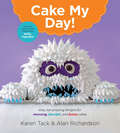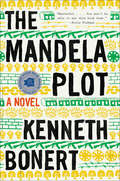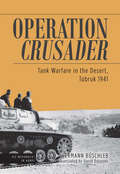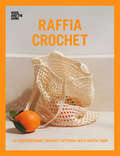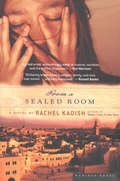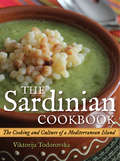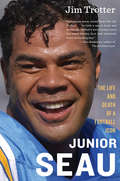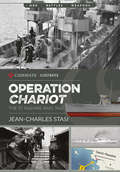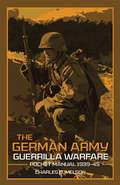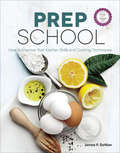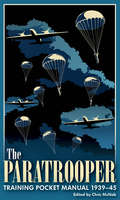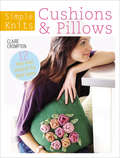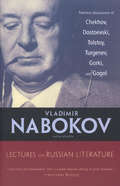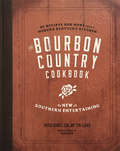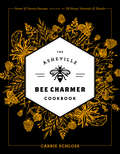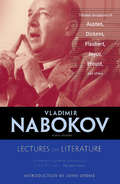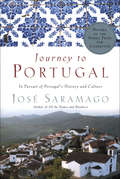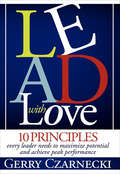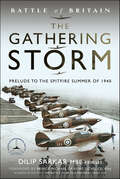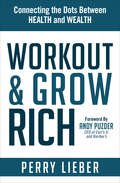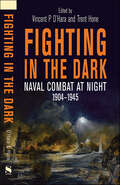- Table View
- List View
Cake My Day!: Easy, Eye-Popping Designs for Stunning, Fanciful, and Funny Cakes
by Alan Richardson Karen TackThe New York Times bestselling authors of Hello, Cupcake! show you how to make a Taxi Cake, a Ladybug Cake, a Siamese Cat Cake, a Guitar Cake, and more. Those cupcaking geniuses, Karen Tack and Alan Richardson, are back, this time with bigger canvases and bolder creations. Everything that can be done with a cupcake can be done better with a cake—with a twelfth of the effort and loads more wow power, using everyday pans, bowls, and even measuring cups. Press candy into frosting for an argyle pattern, or use one of the easy new decorating techniques to produce wood grain for a guitar cake. Turn a round cake into Swiss cheese and Brie for April Fool&’s Day. Whether you&’re a kitchen klutz or a master decorator, you can transform a loaf cake into a retro vacuum cleaner for Mom or bake a cake in a bowl for a rag doll. Need a piñata for a birthday party? Bake the batter in a measuring cup. Or skip the baking altogether, buy a pound cake, and fashion it into a work boot for Dad or a high-top sneaker. You won&’t believe these creations aren&’t the real thing—until you take the first delicious bite!
The Mandela Plot: A Novel
by Kenneth BonertA Jewish teenager is drawn into the political violence of apartheid South Africa in this &“riveting thriller&” by the award-winning author of The Lion Seeker (Booklist, starred review). As the 1980s draw to a close, apartheid is in its death throes and South Africa is a maelstrom of social unrest. Johannesburg teenager Martin Helger has problems of his own. The son of a Jewish scrap dealer, he&’s out of place at his elite private school. When an American named Annie comes to stay with his family, Martin becomes transfixed. But as he gets closer to her, he finds himself wrenched from his privileged bubble and thrust into the raw heart of South Africa's racial struggle. Meanwhile, secrets from the past begin to emerge and old sins return to tear Martin&’s family apart, even as the larger forces of history and politics tear apart the country. At once a riveting literary thriller, a moving coming-of-age tale, and an unforgettable journey through a fascinating world, The Mandela Plot entertains and terrifies in equal measure.A Finalist for the National Jewish Book Award
Operation Crusader: Tank Warfare in the Desert, Tobruk 1941 (Die Wehrmacht im Kampf)
by Hermann BuschlebA 1960s German perspective of the World War II battle in Libya and how the Allied and Axis commanders shaped the course of the action. The port city of Tobruk, Libya, was besieged by German and Italian forces in April, 1941. Following an abortive attempt in June, the Allies made a second attempt in late November, when the Eighth Army launched Operation Crusader, aimed at destroying the Axis armored force then advancing. After several inconclusive engagements, the British 7th Armoured Division was defeated by the Afrika Korps at Sidi Rezegh. Erwin Rommel was then forced to withdraw his troops to the defensive line at Gazala, making the operation the first Allied victory over German land forces in World War II. This account of the tank warfare during Operation Crusader in front of Tobruk in the fall of 1941 examines the roles of commanders in the battles of Operation Crusader, in particular the part of Rommel, who achieved some defensive successes during combat. As well as examining the part of commanders, it discusses the parameters of the battle: the terrain, weather, visibility, logistics, intelligence, and the forces involved. It then narrates the course of the battle, and the result.
Raffia Crochet: 10 Contemporary Crochet Patterns with Raffia Yarn
by Wool and the GangThe DIY fashion brand presents ten fun and easy crochet projects featuring Ra-Ra Raffia—the endlessly versatile plant-based yarn. Raffia yarn is made of one-hundred percent long wood fiber, making it not only vegan and biodegradable, but also water-repellent and quick-drying. This light and eco-friendly yarn adds structure to your projects, making it perfect for crocheting hats, bags and other accessories. Here you&’ll find ten crochet projects that show off the ease, versatility and style of Wool and the Gang's line of Ra-Ra Raffia yarns. Ranging from beginner to intermediate skill levels, the projects include bags, hats and baskets, which are then further embellished with raffia yarn embroidery. General techniques are covered at the end of the book, with step-by-step instructions accompanied by clear illustrations.
From a Sealed Room
by Rachel KadishFrom the USA Today bestselling author of The Weight of Ink, &“a tale of war and peace that moves us from Jerusalem to New York and back again&” (San Francisco Chronicle). In this affecting, perceptive novel, Rachel Kadish reflects on the ghosts of the past, the tensions of war, and the difficult bonds of family. When Maya enrolls at Hebrew University in Jerusalem shortly after the Gulf War, she hopes to leave New York and a fraught relationship with her mother behind her. In Israel, she gets to know her older cousin Tami, a housewife whose home has a room sealed against the war&’s Scud missile attacks. Like Maya, Tami feels distanced from the people closest to her—her mother, her husband, her only son. But it will ultimately be Maya&’s visits with Shifra, an elderly recluse and Holocaust survivor who lives in the apartment below her, that give Maya the courage to confront her problems and break free of the burdens of her past. Praise for Rachel Kadish and From a Sealed Room &“A gifted writer, astonishingly adept at nuance, narration, and the politics of passion.&”—Toni Morrison &“Brilliantly braids history, religion, family, and eros. I was moved . . . and very impressed.&”—Russel Banks &“An intense, ambitious story that explores the chasms between the truth and falsehood, past and present.&”—The New York Times Book Review &“What makes this book so rich and historically resonant is the skill and boldness with which Kadish weaves the intersecting stories of three women representing three generations.&”—Chicago Tribune &“A poignant and a surprisingly powerful tale.&”—The Boston Globe
The Sardinian Cookbook: The Cooking and Culture of a Mediterranean Island
by Viktorija TodorovskaThe author of The Puglian Cookbook heads to the Italian island of Sardinia for a unique twist on the Mediterranean diet. Sardinia, the isolated and majestic island off the southwest coast of Italy, has a rich and ancient history as home to different Mediterranean peoples whose customs have intertwined over the centuries. The result is an unparalleled richness of cuisine. The Sardinian Cookbook captures these wonderful flavors, delivering more than 100 easy-to-make recipes that are as healthful as they are delicious. Sardinia is an island of many distinct landscapes and nationalities, from its rugged interior and breathtaking coastline to its diverse blend of Spanish, French, Italian, and Moorish cultures. From myrtle, saffron, and honey to lamb, seafood, and specialty cheeses, Sardinian food features a broad variety of flavors for any occasion. Many traditional Sardinian recipes are simple and straightforward—reflecting the peasant cuisine heavy on legumes, fresh vegetables, olive oil, and bread. However, it is common for Sardinians to celebrate holidays with lavish feasts and special delicacies: suckling pig, lobster, bottarga (Sardinian caviar), and the full-bodied yet natural flavorings of Sardinian sausages. Praise for The Puglian Cookbook &“We love that before cranking up the heat at the stove, Todorovska pauses to make sure we have a deep understanding of the ingredients that are the fundamentals of Puglian cuisine. She writes for the home cook, with no fancy tricks, no hard-to-find ingredients.&” —Chicago Tribune &“For those who want a taste of excellent, yet different Italian cooking, The Puglian Cookbook is not to be missed.&” —Midwest Book Review
Junior Seau: The Life and Death of a Football Icon (Superstar Ser. #Vol. 7)
by Jim TrotterThis intimate biography of the NFL icon by a veteran sports reporter sheds light on his singular life and the controversy surrounding his tragic death. Tiaina Baul &“Junior&” Seau is widely considered to be among the best linebackers in NFL history, a ten-time All-Pro, a twelve-time Pro Bowl selection, and a first-ballot entrant into the Pro Football Hall of Fame. But in 2012, just two years after retiring from football, Junior Seau committed suicide. Studies of his brain by the National Institutes of Health concluded that Seau suffered from chronic traumatic encephalopathy (CTE), a brain disease often caused by repeated hits to the head. Seau&’s suicide spawned numerous investigations into the brains of deceased NFL players, and many were found to have CTE. Drawing on exclusive access to Seau&’s family as well as Seau&’s never-before-seen diaries and letters, Jim Trotter paints a moving and revealing portrait of a larger-than-life sports star whose achievements on the field were rivaled by his personal demons.&“Few people knew Junior Seau like Jim Trotter . . . he took a sports book and artistically crafted it into a lyrical narrative about dreams, love, and, ultimately, heart-wrenching loss.&”—Lars Anderson, author of The All Americans
The Busy Girl's Guide to Cake Decorating: The Fast, Simple Way to Impressive Cakes and Bakes
by Ruth ClemensA quick and easy guide to cake decoration by the bestselling author of Creative Éclairs and finalist from The Great British Bake Off. Discover how even the busiest chef can whip up impressive homemade treats in next to no time! Ruth Clemens, finalist on the first series of The Great British Bake Off, shares her secrets in creating quick-but-gorgeous cakes, bakes, and biscuits. Choose from twenty-five beautiful, fuss-free projects to make in under an hour, in an afternoon, or over a weekend and be amazed at what you can achieve! The simple projects are split into three sections. The Evening Whip-Ups (one-hour projects) are perfect when you have very little time, and are easy to throw together one evening after work. The Half-Day Delights (two-hour projects) are for when you have an afternoon to spare. Finally, the Weekend Wonders (three- to four-hour projects) are for when you&’ve got a bit more time available in your schedule! In addition, Ruth outlines all the equipment and ingredients you need, shows how to line a cake tin, and gives her tried-and-tested recipes for fruit cake, sponge cake, and chocolate cake, as well as cupcake recipes, cookie recipes, and frosting recipes. You will learn how to decorate easily with royal icing, buttercream, marzipan, sugar paste, and ribbon, as well as how to color fondant to your desired shade, how to stack cakes using dowels, and some wonderful creative embellishment techniques.The Busy Girl&’s Guide to Cake Decorating—the perfect place to start your foray into the world of cakes!
Operation Chariot: The St Nazaire Raid, 1942 (Casemate Illustrated #Cis0013)
by Jean-Charles StasiAn illustrated history of the World War II British amphibious attack on a dry dock in the German-occupied French town. At the beginning of 1942, the prospect of Germany&’s Tirpitz, the heaviest battleship ever built by a European navy, patrolling the Atlantic posed a huge threat to the convoys that were the lifeline for Britain. Bombing raids to destroy the ship failed. A more radical plan was conceived to destroy the dry-dock facility at St Nazaire on the French Atlantic coast. Without the use of the only suitable base for the ship, the threat would be neutralized. The plan was to ram the entrance gates with a ship packed with explosives on a delayed fuse. A motorboat armed with torpedoes would fire at the inner gate causing further damage to submarine pens. The troops and crew would then destroy as many dockyard targets as they could and withdraw in fast motor launches that had followed them in. All this was to be achieved under cover of an air raid. HMS Campbeltown, a U.S. lend-lease destroyer, was chosen for the task. On the night of March 27, the raid commenced. The Campbeltown succeeded in lodging its bows in the outer gates. The fuses detonated the explosives in its hold the following day. The dock gates were destroyed. The cost to the Allies was high, but the Tirpitz was never able to leave Norwegian waters. This volume in the Casemate Illustrated series gives a clear overview of the planning and execution of the raid and its aftermath, accompanied by 125 photographs and images, including color profiles and maps.
The German Army Guerrilla Warfare: Pocket Manual, 1939–45 (The Pocket Manual Series)
by Charles D. MelsonAn exploration of German World War II small-scale military strategy, edited by the former chief historian of the U.S. Marines. While small wars are not new, how they should be fought by a modern industrial nation is still very much a matter for debate. It is thus worth paying heed now to the experiences of another power which once encountered the same problems. This pocket manual examines German analysis of the problem, covering experiences from the Napoleonic era to the Third Reich, based upon the historical analysis, Kleinkrieg, provided to the German High Command by Arthur Ehrhardt in 1935 (republished in 1942 and 1944), and the Bandenbekampfung (Fighting the Guerrilla Bands) document provided to Germany&’s OKW in 1944. In both, conditions that were specific to broader military operations were separated from circumstances in occupation campaigns, and the new background in the German experience in suppressing rebellion during the Second World War is presented. Avoiding ideological biases, this manual examines the purely military problem as seen by professionals. Rediscovered and presented in English, these German thoughts on how best to fight small wars have been edited and annotated by Charles D. Melson, former chief historian for the U.S. Marine Corps. &“The German attitude to guerrilla war was far more complex than stereotypical brutality for the sake of brutality.&” —Stephen G. Fritz, PhD, author of Ostkrieg &“A highly accessible introduction to an important, but frequently neglected, aspect of German military history as well for those interested in guerrilla warfare.&” —Bruce I. Gudmundsson, PhD, U.S. Marine Corps University, author of On Artillery
Prep School: How to Improve Your Kitchen Skills and Cooking Techniques
by James P. DeWanAn IACP Cookbook Award finalist. &“A good primer for beginning cooks and an excellent reference for experienced cooks needing a refresher.&” —ChicagoNow Prep School is the ultimate collection of the weekly Chicago Tribune column of the same name, written by culinary instructor and award-winning food writer James P. DeWan. This compilation is focused on teaching readers how to become better cooks, from amateurs who are learning to cook for themselves or their families to professional and gourmet chefs who are searching to perfect their technique. Illustrated with full-color photography and a plethora of simple, plainspoken instructions, Prep School is an easy go-to guide for becoming more adept at any kitchen skill. Prep School is filled with more than fifty delicious recipes, as well as insightful and straightforward tips on knife skills, preparation techniques, pantry essentials, holiday meals, and general advice on how to make your kitchen as user-friendly as possible. Before any home cook or professional chef picks up a cookbook, they should first pick up Prep School and be sure to take DeWan&’s advice to heart. His recommendations on improving kitchen efficiency and ease, along with his in-depth knowledge of shortcuts and cooking common sense, make DeWan the perfect teacher for any aspiring culinary student. Finalist for 2014 International Association of Culinary Professionals&’ Best Compilation Cookbook Award &“From cooking with booze to conquering crab cakes, reading James P. DeWan&’s column has helped me graduate from cooking like I still live in a college dorm.&” —RedEye
Diabetes Snacks, Treats, and Easy Eats: 130 Recipes You'll Make Again and Again
by Barbara Grunes Linda R. YoakamThe author of Healthy Grilling &“focuses on encouraging the consumption of good, wholesome foods, not on making junk food less junky&” (Debra Edidin, MD, pediatric endocrinologist, Northwestern University Medical School). Like everyone else, people with type II diabetes don&’t have much time to cook, don&’t want to deal with &“gourmet&” recipes, and just want to eat their favorite dishes. They want to pop something in the oven, under the broiler, or on the gas grill, and eat what they like without worrying that it will be harmful to them. If they are kids (and the increase of diabetes among teens is alarming), they want to find some ready-to-munch snacks waiting for them. In this must-have cookbook, you&’ll find . . . · 150 recipes for snacks, dips, munchies, appetizers, main courses, side dishes, vegetarian treats, beverages, cakes, pies, cookies and brownies, and desserts—even ice cream—that are low in fat, carbohydrates, and sodium, created especially for people with diabetes · Dishes that are really easy to make—most take less than 20 minutes to prepare, use less than four ingredients plus condiments, and don&’t require much in the way of cooking skills · Pantry basics that make quick cooking a breeze. · Special section of meals and snacks kids like. · Nutrition analysis and exchanges for each recipe. · Introduction by a Certified Diabetes Educator covering basics of cooking for people with diabetes.
The Paratrooper Training Pocket Manual, 1939–45 (The Pocket Manual Series)
by Chris McNabDuring World War II, it quickly became apparent that the physical and tactical demands placed upon paratroopers required men of exceptional stamina, courage and intelligence. To create these soldiers, levels of training were unusually punishing and protracted, and those who came through to take their &“wings&” were a true elite. The Paratrooper Training Pocket Manual 1939–1945 provides an unusually detailed look into what it took to make a military paratrooper during the Second World War, and how he was then utilized in actions where expected survival might be measured in a matter of days. Using archive material from British, U.S., German and other primary sources—many never before published—this book explains paratrooper theory, training, and practice in detail. The content includes: details of the physical training, instruction in static-line parachute deployment, handling the various types of parachutes and harnesses, landing on dangerous terrain, small-arms handling, airborne deployment of heavier combat equipment, landing in hostile drop zones, tactics in the first minutes of landing, radio comms, and much more. Featuring original manual diagrams and illustrations, plus new introductory text explaining the history and context of airborne warfare, The Paratrooper Training Pocket Manual 1939–1945 provides a detailed insight into the principles and practice of this unique type of combat soldier.
Simple Knits: 12 Easy-Knit Projects for Your Home (Simple Knits)
by Claire CromptonPatterns for the coziest and cutest cushions, seating cubes, and pillows from the established designer and bestselling author of The Knitter&’s Bible. Featuring strong designs across a range of styles for the new-to-knitting market, all the projects included are either Beginner, Easy or Intermediate skill level, and the majority are Easy. As well as patterns and project instructions, you will also find an explanation of the abbreviations used, a knitting needle conversion chart, a skill level key, a standard yarn weight chart, knitting techniques and making-up techniques. Projects include: · Pompom Cushion · Bright Stripe Pillows · Beaded Cushions · Black and White Pillow · Vibrant Seating Cube · Fringed Ribbon Pillow · French Knitted Cushions · Blooming Rose Pillow · Diamond Pattern Pillow · Bunting Cushion
Diabetes Snacks, Treats, & Easy Eats for Kids: 150 Recipes for the Foods Kids Really Like to Eat
by Barbara Grunes Linda R. YoakamChild-friendly recipes that fit into your busy lifestyle and offer healthy—and tasty—alternatives to today&’s fast food meals and sugary snacks. This redesigned and expanded third edition of Diabetes Snacks, Treats, and Easy Eats for Kids offers even more simple, delicious recipes for healthy, well-balanced diets. Since the book was first published in 2006, the prevalence of diabetes in children has continued to increase. Children under age nineteen have seen a twenty-one percent increase in Type 1 cases, and children ages ten to nineteen have seen a thirty percent increase in cases of Type 2—a disease that used to be considered an adult condition. But kids will be kids, and when they come home from school, they want a snack that&’s simple, satisfying, and occasionally sweet. When it comes to dinner, they usually don&’t have the time or the taste for fancy meals. With this in mind, author Barbara Grunes has developed more than 150 recipes for snacks and meals that kids really like and that stay within diabetic guidelines. Grunes&’s goal is to help all kids enjoy food that is good for them—even if they have diabetes. Each recipe includes the nutritional information readers need, whether they count carbs or use the exchange method. With recipes like Pizza Puffs, Spud Pancakes, Chicken Fajitas, Ice Cream Cone Cupcakes, and Fruit Turnovers, this book proves that everyone can enjoy familiar and delicious food together. After all, it&’s not about &“good,&” &“bad,&” or &“forbidden&” foods—it&’s about readers feeding their families sensibly.
Lectures on Russian Literature
by Vladimir NabokovThe acclaimed author presents his unique insights into the works of great Russian authors including Tolstoy, Dostoevski, Gogol, Gorki, and Chekhov. In the 1940s, when Vladimir Nabokov first embarked on his academic career in the United States, he brought with him hundreds of original lectures on the authors he most admired. For two decades those lectures served as the basis for Nabokov&’s teaching, first at Wellesley and then at Cornell, as he introduced undergraduates to the delights of great fiction. This volume collects Nabokov&’s famous lectures on 19th century Russian literature, with analysis and commentary on Nikolay Gogol&’s Dead Souls and &“The Overcoat&”; Ivan Turgenev&’s Fathers and Sons; Maxim Gorki&’s &“On the Rafts&”; Leo Tolstoy&’s Anna Karenina and The Death of Ivan Ilych; two short stories and a play by Anton Chekhov; and several works by Fyodor Dostoevski, including Crime and Punishment, The Idiot, and The Possessed. This volume also includes Nabokov&’s lectures on the art of translation, the nature of Russian censorship, and other topics. Featured throughout the volume are photographic reproductions of Nabokov&’s original notes. &“This volume . . . never once fails to instruct and stimulate. This is a great Russian talking of great Russians.&” —Anthony Burgess Introduction by Fredson Bowers
The Bourbon Country Cookbook: New Southern Entertaining
by David Danielson Tim Laird&“A book that will stand as one of the most essential cookbooks in the history of Southern cuisine.&” —Edward Lee, chef and author of the James Beard Award–winner of Buttermilk Graffiti Bourbon, the first uniquely American distilled spirit, is nearly synonymous with Kentucky, its birthplace. However, it has come a long way since it was first distilled in the late 1700s, and its popularity and refinement have never been greater. At the same time, southern cuisine has evolved to keep up with bourbon&’s evolution through once unheard-of collaborations between kitchen and bar, a renewed interest in seasonal local ingredients, and the influence of the delicious food traditions of the region&’s growing migrant populations. This book distills the spirit and hospitality—both new and old—of great southern food and drink into ninety accessible recipes designed to help you achieve the ease and elegance of Bourbon Country entertaining in your own home. Arranged by the kind of traditional fare you&’d find on a Kentucky table—pickles, vegetables, ancient grains, bounties from the barnyard, bourbon cocktails, and more—these recipes pay homage to the rituals and victuals of yesteryear while embracing the new southern palate and the flavors of modern Kentucky bourbon. &“Farm fresh and artisanal aren&’t trends in the bluegrass state, but a long-established way of life. Add the resonant ring of the finest American distillation—Kentucky bourbon—as these brilliant chefs do, and you&’ve created magnificence and memories. In fact, the recipes, stories, and photographs here are so fine, you won&’t want to wait for a horse race, but use this book year &’round.&” —Ronni Lundy, author of the James Beard Award–winner Victuals
The Asheville Bee Charmer Cookbook: Sweet and Savory Recipes Inspired by 28 Honey Varietals and Blends
by Carrie Schloss&“A beautiful tribute . . . From breakfast pastries to exotic marinades to unexpected desserts, Carrie Schloss explores the many sides of honey. &” —Ashlee Aubin, executive chef, Fisk & Co. Asheville Bee Charmer, opened in 2014 by beekeepers Jillian Kelly and Kim Allen, has become a destination for both local foodies and tourists. This honey purveyor, located in one of the most pollinator-friendly parts of the United States, offers a range of bee-related products and more than fifty different artisanal honey varietals—each with its own unique color, texture, and taste. Inspired by the vast honey selection available behind the Honey Bar, chef Carrie Schloss has created The Asheville Bee Charmer Cookbook, a collection featuring 130 recipes, twenty honey varietals, and eight special Bee Charmer blends. With a color, aroma, and tasting guide to honey varietals and dishes like Bee Pollen Nut Brittle, Chipotle Honey–Marinated Skirt Steak, and Milk and Honey Dinner Rolls, this cookbook proves that honey is the best way to season or sweeten your next meal. Schloss writes with the home cook in mind, packing complex, surprising flavors into recipes written in clear, accessible prose, and the recipes are accompanied by beautiful full-color photography throughout. &“An inspiration . . . Cooks of every level will leave the sugar in their cupboards and reach for their new favorite local varietal instead.&” —Chris Pandel, chef/partner, Swift & Sons &“A lovely testimonial to the significance of the honeybee. With these delicious, approachable recipes, being good stewards of the land has never tasted so sweet. &” —Laurell Sims, urban farmer, beekeeper, and Slow Food Chicago board member
Lectures on Literature (Vib Ser. #Vol. 227)
by Vladimir NabokovThe acclaimed author of Lolita offers unique insight into works by James Joyce, Franz Kafka, Jane Austen, and others—with an introduction by John Updike. In the 1940s, when Vladimir Nabokov first embarked on his academic career in the United States, he brought with him hundreds of original lectures on the authors he most admired. For two decades those lectures served as the basis for Nabokov&’s teaching, first at Wellesley and then at Cornell, as he introduced undergraduates to the delights of great fiction. This volume collects Nabokov&’s famous lectures on Western European literature, with analysis and commentary on Charles Dickens&’s Bleak House, Gustav Flaubert&’s Madam Bovary, Marcel Proust&’s The Walk by Swann&’s Place, Robert Louis Stevenson&’s &“The Strange Case of Dr. Jekyll and Mr. Hyde,&” and other works. This volume also includes photographic reproductions of Nabokov&’s original notes, revealing his own edits, underlined passages, and more. Edited and with a Foreword by Fredson BowersIntroduction by John Updike
Journey to Portugal: In Pursuit of Portugal's History and Culture
by José SaramagoThe Nobel Prize–winning author explores his homeland in &“this monumental work, a literary hybrid&” of cultural history, literary nonfiction, and travelogue (Publishers Weekly). In 1979, José Saramago decided to write a book called Journey to Portugal—and dedicated himself to obtaining the fullest meaning of his title. More than merely journeying in or through his native country, he wanted to achieve a deep encounter with it, foregoing the conventional assumptions and the routines of tourist guides. Instead, he scoured the country with the eyes and ears of an observer fascinated by the ancient myths and history of his people. Recording his experiences and observations across the length and breadth of Portugal, Saramago brings the country to life as only a writer of his brilliance can. Whether an inaccessible medieval fortress set on a cliff, a wayside chapel thick with cobwebs, or a grand mansion in the city, the extraordinary places of this land come alive with kings, warriors, painters, explorers, writers, saints, and sinners. Infused with the tenderness and intelligence that have become familiar to his readers, Saramago's Journey to Portugal is an ode of love for a country and its rich traditions.
Lead with Love: 10 Principles Every Leader Needs to Maximize Potential and Achieve Peak Performance
by Gerry Czarnecki&“Any manager aspiring to superior leadership would be wise to study Gerry&’s advice&” (H. Wayne Huizenga). Lead with Love is like no other leadership book you have read. Arguing that all leaders must begin with love as their first principle, the author integrates this carefully defined concept into each of his remaining nine key leadership principles—ultimately revealing how passion, and an emotional connection with the organization&’s mission, vision and values, will drive success. These ten principles apply to CEOs who lead companies; executive directors who lead nonprofits; chairmen who lead their peers on corporate boards; coaches who lead athletic teams; teachers who lead classes; mothers who lead households; pastors who lead congregations; foremen who get the plant output manufactured every day. If others look to you for leadership, guidance, or inspiration to achieve goals, there&’s much to learn in this book that has been praised by tough-minded entrepreneurs and spiritually empowering thought leaders alike.
The Gathering Storm: Prelude to the Spitfire Summer of 1940 (Battle of Britain)
by Dilip SarkarDilip Sarkar has studied the Battle of Britain period for a lifetime and is renowned for his meticulous research and evidence-based approach, setting events within the broadest possible context. In doing so, he has helped enrich our appreciation and understanding of the past. In this, the first of a new seven volume series on the Battle of Britain, we have the background to the aerial conflict of the summer of 1940 revealed in great detail and told comprehensively as never before. No stone has been left unturned, no angle unexplored. This meticulous approach the research, combined with the human stories and events, many revealed for the first time, tells what Dilip calls ‘the Big Story’. The development of air power, the creation of Britain’s defenses, the German side, the Home Front and political events are all covered – and much more. After considering the background threads prior to the outbreak of war in 1939, this book then describes the developing conflict on land, sea and in the air. The German invasion of Norway, the Fall of France and the air fighting over Dunkirk are all explored, along with Hitler’s actual preferred policy towards Britain, which at first was one of blockade – not invasion. The author, with justification, questions the validity of the Battle of Britain’s official start-date being 10 July 1940, evidencing the fact that the fighting actually began eight days earlier. From that date onwards, a day-by-day, hour-by-hour, account of the fighting is provided, giving due recognition to those aircrew lost or wounded before 10 July 1940, and whose names are not, therefore, found amongst ‘The Few’. Due accord is also given to the Royal Navy, and efforts of both Bomber and Coastal commands, emphasizing just what a ‘big’ story this actually is – far from simply concerning a handful of Spitfire and Hurricane pilots. Through diligent research with crucial official primary sources and personal papers, Dilip unravels many myths, often challenging the accepted narrative. This is not, however, simply another dull record of combat losses and claims, far from it. Drawing upon unique first-hand accounts from a wide-range of combatants and eyewitnesses, along with the daily Home Intelligence Reports and the papers of politicians such as Italian Foreign Minister Count Ciano, this really is an unprecedented approach to understanding the build-up to and times of the Battle of Britain.
Workout & Grow Rich: Connecting the Dots Between Health and Wealth
by Perry LieberCreate a healthy culture for success in work and life with advice from an elite personal trainer and president of FoundWellness: the Workplace Workout. As a personal trainer, Perry Lieber has been part of his clients&’ successes, and he knows that working out is linked directly to better performance in the workplace. In Workout and Grow Rich, Lieber explores that link to its fullest extent, teaching readers what it means to be truly rich in every definition of the word. There have been many books written about how to lead a more successful and fulfilling life, but there are few to none that claim working out as the secret to discovering that success. Workout and Grow Rich takes readers on a step-by-step journey to learn the same techniques used by athletes, corporate leaders, and celebrities to incorporate personal fitness into their busy schedules. As a workplace expert himself, Lieber knows the difficulties associated with maintaining a healthy lifestyle. In Workout and Grow Rich, he includes interviews with some of his most successful clients, like Greg Renker, founder of Guthy-Renker, and Mark Bissell, CEO of Bissell, to tell readers directly how Lieber&’s strategies improved their lives.
Fighting in the Dark: Naval Combat at Night, 1904–1945
by Vincent O’Hara and Trent HoneFighting in the Dark is a new book about naval combat at night; the title also, however, signifies the overarching theme of the book, of moving from dark to light: in short, the process of mastering technological change during war. The authors start with the proposition that it is hard to hit an invisible target, particularly one in motion. In the nineteenth century, when ships relied upon visual signaling and vessels beyond hailing range were deaf and mute in the dark, night battles at sea were rare and largely accidental. Three inventions changed this: the torpedo, the searchlight, and the radio. These inventions at the end of the nineteenth and start of the twentieth centuries transformed naval warfare by making combat in the dark feasible and in some cases, desirable. The process by which navies used the dark and adapted it into a medium for effective combat was long and difficult, more so for some than others. This book is about that process and about how Russian, British, German, Italian, Japanese and US navies confronted the specific new challenges and adapted to unfamiliar situations and emerging technologies. Fighting in the Dark consists of chapters written by a group of highly respected naval historians, and the book’s approach illuminates how different navies and cultures approached common problems. The fierce night-time battles that are described serve as a metaphor for the larger issues and the reader is led along a fascinating journey of naval warfare from the Russo-Japanese War, through WWI, to the Second World War, and from the Pacific to the English Channel.
Marcus Furius Camillus: The Life of Rome's Second Founder
by Marc HydenThis is the only modern biography of Marcus Furius Camillus currently available in English. Camillus served as a censor, was elected to six consular tribuneships, appointed dictator five times, and enjoyed four triumphs. He toppled mighty Veii, ejected the Senones from Rome following its sacking, and helped orchestrate a grand compromise between the patricians and plebeians. The Romans even considered him Rome’s second founder – a proud appellation for any Roman – and revered him for being an exemplar of Roman virtue. Interestingly, he never held the consulship. Plutarch stated that Camillus had avoided it on purpose, and for good reason. The office was often at the heart of controversy, given that patricians dominated it for most of Camillus’ life. The appointment of a dictator was an emergency measure taken only in the direst of situations and the fact that Camillus was repeatedly appointed speaks of a period when the young Republic was surrounded by enemies and still fighting for survival. Without Camillus’ efforts the city may never have fulfilled its great destiny. Marc Hyden sifts the fragmentary and contradictory sources and, while acknowledging that much legend and exaggeration quickly accrued around Camillus’ name, presents the story of this remarkable life as the ancient Romans knew it.
